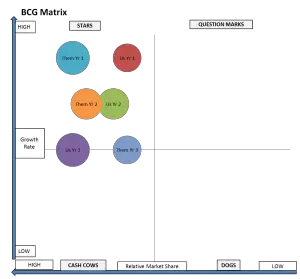The BCG matrix and Competitor Analysis
The BCG matrix can be utilized to help analyze competition. This makes a lot of sense, given that one of the key determinants of classifying a product into one of the four quadrants is relative market share – therefore, the outcomes of the BCG matrix are based around this competitive position. Also please refer to the discussion of when to use the BCG matrix.
In this example of using the BCG matrix, two firms are mapped – and to make the discussion easy, they had simply been labeled us and them.
The same firms have had their position mapped for a three-year period. You should notice that one firm (us) is generally improving in terms of relative market share, at the expense of our competitor (them).
As we know, the key goal of a star is to manage it effectively, support it, invest and develop it – in order to build a cash cow in the future. This diagram of the BCG matrix provides a good example of the path that a star should take.
However, for the purposes of discussion, let’s go back to the year one scenario – where both firms had stars, yet our competitor had a relative market share advantage. At this point of the competitive situation, a key goal for us would be to build market share and become the market leader. If we failed to do that, then we run the risk of our position eroding and deteriorating back to a question mark and then ultimately down to a dog.
PGE2 position highlights that we had made significant improvements and that our catch up strategy was working – this would signal to the firm that we need to continue the current strategy and even reinforce it in order to generate an even stronger position of acquiring annexed cash cow.
As you can see, by year three the market growth had reduced and our firm will have the more significant cash cow, which probably cannot be overtaken in a mature market.
Industry growth versus company growth
 Another approach to analyzing competition is using a scatter chart/graph that is based upon the BCG matrix. In this particular chart – as shown here – growth rates of both the market/industry and the firm’s portfolio are shown together.
Another approach to analyzing competition is using a scatter chart/graph that is based upon the BCG matrix. In this particular chart – as shown here – growth rates of both the market/industry and the firm’s portfolio are shown together.
On the left-hand side of the chart there is a significant concern as the market is outperforming the firm’s growth – this will mean that stars are likely to deteriorate towards question marks and cash cow are likely to head towards dogs.
On the right-hand side of the chart is the preferred position – where the firm’s growth rate is exceeding the industry. In this case, the firm’s market shares will be increasing, thus pushing the firm’s portfolios from right to left on the BCG matrix – which is the preferred direction.
Related topics
Please download the free Excel template for making the BCG matrix
What is a good and poor BCG matrix portfolio?
When to use the BCG matrix?
